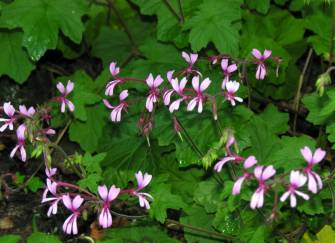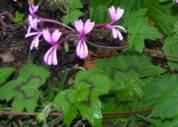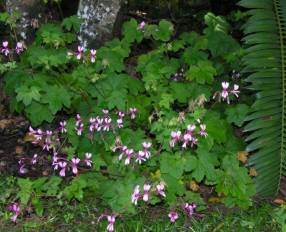Pelargonium transvaalense
Pelargonium transvaalense Knuth
Family: Geraniaceae
Common names: Transvaal perlagonium (Eng)
Introduction
This plant has grown in the Lowveld National Botanical Garden happily for many years in both sunny and shady positions.

Description
Description
Pelargonium transvaalense is a deciduous, tuberous herbaceous perennial, low growing and multi-branched. Plants can grow up to 0.8 m and they normally scramble or creep sideways. Plants unselfishly flower the entire summer (September-May) and they can be identified by their attractive pink (with carmine red veins) flowers, together with their large lobed leaves, which are sporadically zoned with dark purple rings.

Distribution and habitat
Distribution description
They are found in only two known localities in South Africa: in Mpumalanga (Barberton area) and in KwaZulu-Natal, approximately 450 km south of the Mpumalanga population. Plants grow in shady, moist places in the forests, at high altitude localities ranging from 600 to 1 400m, with annual rainfall of about 800 to 1400 mm throughout the summer season.
Derivation of name and historical aspects
History
Pelargonium = Perlagos (Greek): meaning, Stork's Bill which refers to the rostrum (beak-like extension) of the schizocarp (dry splitting fruit into 2 or more parts) which resembles the bill of a stork and transvaalense = refers to the Transvaal Province where it was first described. This area is currently named Mpumalanga.

Plant material of P. transvaalense was first collected in 1883 by John Medley Wood in KwaZulu-Natal, but was formally described for the first time from specimen collected by Galpin (famous herbarium material collector) in 1890. Further reports indicate that, early in the 20 th century live plants were taken to the Cambridge Botanical Garden in England, and were reported to be "extremely pretty and interesting" (Van der Walt & Vorster, 1981).
Uses
Use
Reputedly used to cure and remedy ailments such as diarrhoea, dysentery, colic and fever, it can be taken either in the form of an infusion or just chewed. Local people from Mpumalanga believe that by chewing only the roots of these plants one will be cured of dysentery.

Growing Pelargonium transvaalense
Grow
Plants are very attractive when planted en masse and thrive in light soil, which is rich in organic matter, particularly leaf mould. For smaller gardens plants can be grouped in threes and scattered around strategically to provide lovely splashes of colour.
In cultivation, contrary to their restricted geographical distribution, plants are very adaptive to various growing conditions. They perform very well in shade, mostly as groundcovers, and are reported to thrive in full sun too, where they flower optimally, forming neat, rounded bushes, however this is subjected to further experimentation. To keep neat, trim and remove dead flowers and leaves regularly during the growing season and when they die back in winter.
They need to be protected from frost, but can survive winter rainfall when dormant as their natural habitat probably remains moist in winter too.
Plants are easily propagated from cuttings and seeds. Best results are obtained from sowing fresh seed where 100% germination can be achieved.
References
- VAN DER WALT, J.J.A. & VORSTER, P.J. 1981. Pelargoniums of southern Africa: Vol. 2. Johannesburg Juta Co.
- WATT, J.M & BREYER-BRANDWIJK, M.G. 1962. Medicinal and poisonous plants of southern and eastern Africa: London. E. & S. Livingstone LTD.
Credits
Tovhowani Mukoma
Lowveld National Botanical Garden
May 2005
Plant Attributes:
Plant Type: Ground Cover, Perennial
SA Distribution: KwaZulu-Natal, Mpumalanga
Soil type: Loam
Flowering season: Early Summer, Late Summer
PH: Neutral
Flower colour: Pink
Aspect: Full Sun, Morning Sun (Semi Shade), Afternoon Sun (Semi Shade)
Gardening skill: Easy
Special Features:
Horticultural zones










Rate this article
Article well written and informative
Rate this plant
Is this an interesting plant?
Login to add your Comment
Back to topNot registered yet? Click here to register.